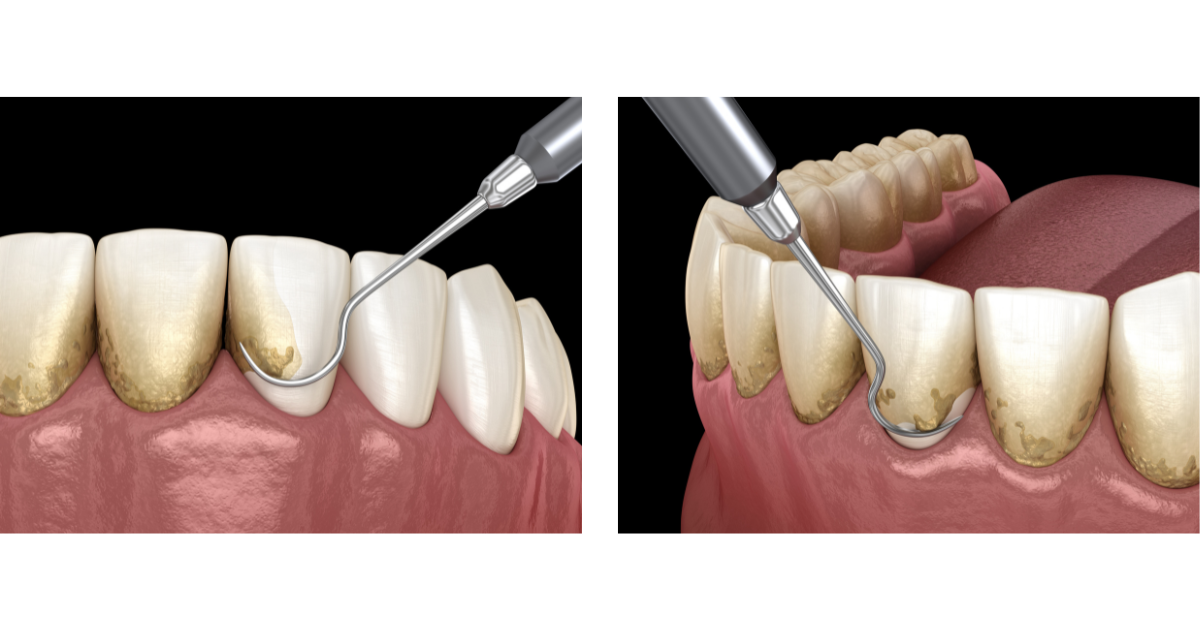Dental scaling and root planing are deep cleaning procedures aimed at treating and preventing gum disease and promoting oral health, usually recommended for those with early gum disease signs. Regular maintenance and follow-up care are crucial to sustaining the benefits of this procedure.

What is dental scaling?
Dental scaling involves removing dental plaque and tartar from the teeth, especially below the gum line. This helps eliminate the primary causes of gum inflammation and infection.
What is root planing?
On the other hand, root planing smoothens the root surfaces of the teeth, removing remaining plaque and tartar. This helps the gums reattach to the teeth and reduces pocket depths, promoting healing and preventing further periodontal issues.
Do I need to get scaling and root planing done?
It is advisable to get full mouth scaling and root planing done once every two years. Other reasons might include:
Gingivitis: Early-stage gum disease characterised by inflammation and bleeding gums.
Periodontitis: Advanced gum disease with deeper periodontal pockets and possible bone loss.
Prophylactic treatment: If you are at high risk of periodontal disease, even without severe symptoms.
Scaling and root planing procedures
1. Assessment
The dentist or dental hygienist would examine your mouth, assessing any plaque and tartar buildup, along with the severity of gum disease. Radiographic images via x-rays may also be taken to check your teeth health.
2. Anaesthesia
Topical or local anaesthesia may be applied to ensure comfort during your procedure and numb the areas being treated.
3. Scaling
Manual instruments such as hand scalers and curettes manually scrape off plaque and tartar from the teeth, while ultrasonic scalers use high-frequency vibrations and water spray to break up and wash away any deposits.
4. Root planing
After scaling, your teeth roots are planed to smoothen out rough surfaces where bacteria can accumulate. Deep cleaning procedures also ensure that all surfaces are clean, promoting better gum reattachment and healing.
What are the benefits of scaling and root planing?
Prevention of gum disease advancement to more severe stages.
Reduces gum inflammation and bleeding, improving overall gum health.
Helps decrease the periodontal pocket depths, making it easier to maintain oral hygiene.
The overall health of the mouth is improved and enhanced, leading to fresher breath and healthier gums.
Aftercare and recovery
Sensitivity — Patients may experience some tooth sensitivity and discomfort for a few days after the procedure.
Oral hygiene — It is important to maintain good oral hygiene practices, such as regular brushing and flossing, to prevent the recurrence of gum disease.
Diet — Soft foods and avoiding extreme temperatures in food and drink can help minimise discomfort during recovery.
Follow-up visits — Regular dental check-ups and cleanings are essential to monitor healing and ensure the continued health of the gums.
What are the risks and considerations involved?
Discomfort — Some discomfort and sensitivity are common after the procedure but typically subside within a few days.
Gum recession — Minor gum recession may occur because of the thorough cleaning.
Infection — There is a slight risk of infection if proper aftercare is not followed, but this is rare.
For more information, contact us:
Thomson Dental Centre
Call: 6255 0770
WhatsApp: 8716 9594
Book an Appointment